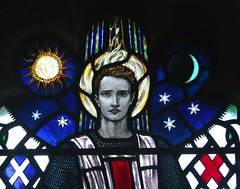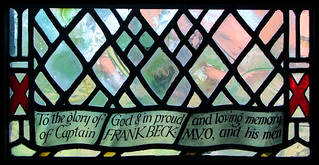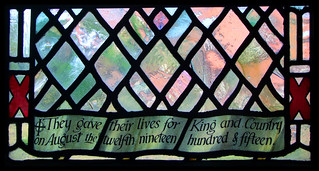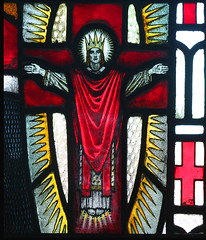| |
|
St Peter
and St Paul, West Newton
 |
|
West
Newton is a pretty little village at the heart of
the Sandringham estate. When I first visited in
2006 I decided that it was the very model of what
an estate village should be. The workers houses
are fine, and constructed to a high standard.
There are workshops that serve the estate, and
one of those friendly-looking social clubs that
you get in villages around here - it is said that
Queen Alexandra disapproved of pubs, and so
Edward VII gave the villages social clubs
instead. All of this is in the Arts and
Crafts vernacular style of the day, and arranged
pleasingly around the church of St Peter and St
Paul on its mound at the heart of the village. On
that day of high summer the sky was blue, the
heat of the day hazy. From the social club, a
wedding reception spilled out onto the slopes
around the church. Children ran around playing,
while red-faced men in suits laughed and clung
tightly to their pints. On such a sunny day it
felt a privilege to be here.
|
And coming
back ten years later felt like a privilege too. Nothing
much had changed, the church still on the crest of its
cushion of a churchyard, still open. The lychgate is a
memorial to the dead of the First World War, many of them
killed on the same day. The name of Captain Frank Beck
stands out.
Beck was
the land agent on the Sandringham estate, the trusted
right hand man of King George V and a favourite of his
mother Queen Alexandra. Despite the King's protestations,
the patriotic Beck formed a 'pals company' of men from
the estate who were attached to the 5th Battalion of the
Norfolk Regiment. They sailed for Gallipolli, and they
were wiped out during the attack on Anafarta in Suvla Bay
on the 12th of August 1915.
Because
they had fallen behind enemy lines, they were listed as
missing, and a local legend grew up that they had
vanished into a mysterious cloud and were taken up out of
this world. This sounds bizarre, but it was of a piece
with legends like the Angel of Mons leading the British
troops to escape death in Flanders, and with the great
rise in spiritualism in this country in the years
immediately after the War. Perhaps it was the dust and
heat of that day which gave rise to the legend. When the
bodies were eventually found and identified, this
knowledge was kept from Queen Alexandra because it was
felt it would be too upsetting for her, and thus she died
believing in the legend. In 1999, the story of Beck and
his company was dramatised by the BBC as All The
King's Men, a horribly appropriate title. Beck was
played by David Jason.
  
 
Through
the lychgate, you come onto the wide mound of the
churchyard. The 14th century tower of the church is grand
and stately, and its solid carstone with freestone
corners looks as if it might be made of gingerbread and
icing. A beautiful contemporary image niche sits beside
the west window. The body of the church is also carstone,
built of blocks on the south side and in slipped layers
on the north, as if this was a vast dry stone wall.
You step
into a small, simple, restored church. The churches of
north-west Norfolk were in a pretty dreadful state by the
middle of the 19th century. There are more ruined
churches around here than anywhere else in England. The
purchase of the Sandringham estate by the Prince of Wales
revitalised the local economy, and his patronage led to
some pretty substantial restorations, most of which were
to a very high standard in terms of both design and
construction.
Few of the
estate restorations were more substantial than that of
West Newton. Apart from the tower, the church was almost
completely rebuilt in 1880. The architect was, perhaps
surprisingly, Arthur Blomfield, who we rarely see on such
an intricate scale in East Anglia. He was working at
Sandringham church at the same time.
| Here,
he is at his highest, putting into practice the
future King's Anglo-catholic sympathies and
producing a very Arts and Crafts feel to the
interior, particularly with the cottage-style
windows in the aisles, with none of the
razzmatazz inflicted on Sandringham. The glass
was commissioned from Heaton, Butler and Bayne,
and although perhaps the workshop was past its
very best by the 1880s, there is a pleasing
harmony to their windows, contributing to a
quiet, intimate interior. The
intimacy of this setting is a perfect foil to the
poignant WWI memorial window of 1920 by Karl
Parsons. This depicts Frank Beck as a magnificent
St George, and remembers the men of his company. They
gave their lives for King and Country on August
the twelfth nineteen hundred and fifteen,
reads the inscription. Interestingly, Queen
Alexandra may never have seen this window, for
she became blind in 1920 and suffered severe
ill-health until her death at Sandringham in
1925. Either side of Beck are the crest of the
Norfolk Regiment and the fiery hell of Suvla Bay.
This is sad enough, but immediately beside it is
another memorial to the men killed further up the
coast at Inkerman during the Crimean War sixty
years earlier. And the men of Norfolk still had
Singapore to come.
|
|
 |
|
|
|
